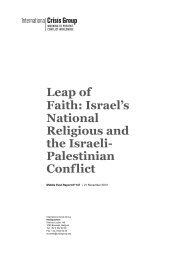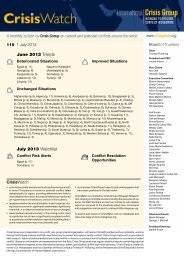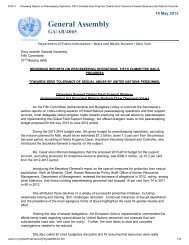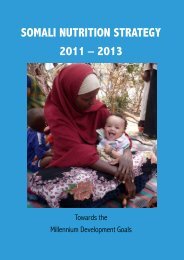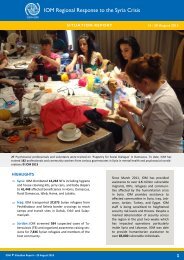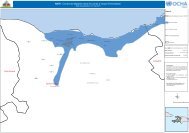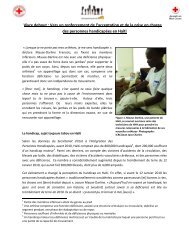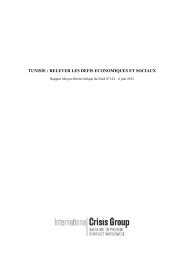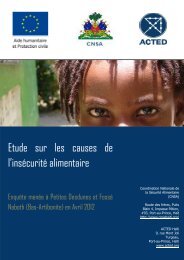Download PDF (682.22 KB) - ReliefWeb
Download PDF (682.22 KB) - ReliefWeb
Download PDF (682.22 KB) - ReliefWeb
You also want an ePaper? Increase the reach of your titles
YUMPU automatically turns print PDFs into web optimized ePapers that Google loves.
DEVELOPMENT OPERATIONAL PLAN<br />
TEMPLATE<br />
For projects run by IFRC secretariat offices worldwide<br />
DOCUMENT INFORMATION<br />
Version number 1<br />
Individual responsible for this draft: Mazin Salloom at 10 October 2013<br />
INTERVENTION INFORMATION<br />
Implementing Secretariat body;<br />
IFRC YEMEN<br />
Host National Society:<br />
Yemen Red Crescent Society<br />
Expected start date:<br />
January 1 st 2014<br />
Project Manager: Mazin Salloom<br />
Geographical coverage<br />
YEMEN<br />
Type of intervention<br />
(sector/area): Health, Disaster<br />
Management (DM), Protection<br />
Expected duration:<br />
Number of people to be<br />
12 months<br />
reached: 180,000<br />
Project Code:<br />
Budget: 500,851 CHF<br />
PYE006<br />
PYE014<br />
PYE100<br />
PYE162<br />
PYE403<br />
Partner National Societies: Danish RC, French RC, German RC, Norwegian RC<br />
Other partner organisations: UN Agencies (UNCHR, UNDP, UNICEF), WFP, INGOs, OXFAM, IOM.<br />
Additional support from country representatives/embassies is being pursued (Japanese, French).<br />
1. Executive Summary<br />
Yemen is often at the bottom of the list of countries set by international agencies, mainly due to issues<br />
related with poverty levels, health, nutrition and gender balance. Statistics generated by WFP, WHO,<br />
Global Gender Report, UNICEF all confirm that the need for service provision is urgent. Poverty rates may<br />
be the prevailing indicator, yet this permeates every aspect of life for Yemeni people. If services are<br />
available, their access is limited.<br />
According to OCHA reports (see statistics below) more than half of the Yemeni population is affected and<br />
is in immediate need of services. The current government is unable to provide basic services to those in<br />
need. It is therefore critical that organizations, specifically local national organizations mitigate the<br />
consequences.<br />
The YRCS has established itself as a national organization, working within the framework of the principles<br />
of the Red Cross/Red Crescent Movement. As such its basic mandate is to provide essential services to<br />
the most vulnerable. The YRCS must, in every instance, complement the services provided by official<br />
government sources, and whenever possible, fill the gaps in essential service provision.<br />
The approach is community-based, thus participation of the community is crucial in identifying the needs,<br />
planning, implementation and quality control (Monitoring & Evaluation).<br />
The role of the Federation transcends the project level and seeks to ensure that the YRCS is:<br />
1. sufficiently supported so that staff & volunteers can work efficiently & effectively to provide much<br />
needed services to the most vulnerable within the Yemeni population<br />
2. able to work together with the RC/RC Movement partners to maximize the outcomes of the<br />
interventions<br />
3. coordinates with other local & international organizations in the provision of services
2. Background<br />
The Republic of Yemen is situated in the strategic further South-Western tip of the Arabian Peninsula and<br />
is inhabited by approximately 24 million people. It is considered the poorest country in the region and<br />
faces major development and economic challenges due to the accumulation of armed conflict, political<br />
and civil unrest, dwindling resources including water and food, and food insecurity. All these factors affect<br />
the wellbeing and health of the people and particularly those in disaster and conflict prone areas.<br />
In March, 2013, a national dialogue started with great momentum and support from international<br />
community which represented a nationwide reconciliation platform to reach a common understanding<br />
between all communities of Yemen population on all critical issues facing the country. The outcomes of<br />
this National Dialogue Conference (NDC), which continued for six month, are expected to be announced<br />
by the end of October 2013. Great expectations are linked to this NDC as it will shape the future of the<br />
country based on political and economic adjustments which might entail rearrangement of administrative<br />
divisions. These measures will also have an impact on humanitarian and development interventions.<br />
Population of Yemen: 23,852,409 [fertility rate of 4.21% (WHO)<br />
The programme will be implemented throughout Yemen. Focus will be on areas with very high poverty<br />
levels and consequently access or availability of basic services including health; WATSAN/hygiene,<br />
nutrition, protection etc. require critical interventions. Efforts will also be taken to target the specific needs<br />
of Returnees & IDPs. In addition, high-risk areas prone to man-made disasters will also be targeted.<br />
See country map & Table below for a summary of overall humanitarian needs<br />
YEMEN: HUMANITARIAN DASHBOARD (OCHA - As of 27 Aug 2013)<br />
13.1 M<br />
AFFECTED<br />
POPULATION<br />
10.5 M<br />
FOOD INSECURE<br />
PEOPLE<br />
1M<br />
OVERALL ACUTE<br />
MALNUTRITION<br />
255,000<br />
SEVERE ACUTE<br />
MALNUTRITION CASES<br />
6.4M<br />
WITHOUT HEALTH<br />
SERVICES<br />
7.1 M<br />
IN CRITICAL WATER<br />
SITUATION<br />
306,027<br />
INTERNALLY<br />
DISPLACED<br />
232,931<br />
RETURNEES<br />
2.1. Initial assessment<br />
In 2013, the United Nations classified the situation in Yemen “one of the world‘s major humanitarian crises,<br />
with more than half of the population affected and a third targeted for humanitarian aid due to its high<br />
vulnerability to natural and human-made disasters”. 1<br />
According to the 2013 UNDP Human Development category, Yemen is positioned at 160 out of 187<br />
countries. 2 Thirteen million people do not have access to safe water and sanitation, 10.5 million are food<br />
insecure, over 300,000 are internally displaced.90, 000 children do not have access to education.<br />
1 OCHA Yemen, July 2013<br />
2
Children are a particularly vulnerable. According to the UNFPA 2010 estimates, almost 48% of the<br />
population is comprised of children under the age of 8. Almost 1 million Yemeni girls and boys under 5 are<br />
suffering from acute malnutrition, of which more than 255,000 have life-threatening severe acute<br />
malnutrition. 3 Apart from disease, children continue to be subjected to and/or exposed to violence in their<br />
homes & communities. In a recent article, the UN Humanitarian Coordinator commented on the particular<br />
vulnerability of children stating that “Women and girls are exposed to gender-based violence, and children<br />
are being recruited by armed groups.” 4<br />
Yemen continues to rank last among 135 countries for women’s progress in the economy, education,<br />
health, and politics, according to the World Economic Forum’s 2012 Global Gender Gap Report. The total<br />
adult literacy rate in Yemen is 55%, yet the disparity between males & females is staggering, with women’s<br />
literacy rate at 30% compared to men at 70%. 5<br />
Problems faced by the rural poor caused by an inter-related chain of inadequate and inaccessible health<br />
services, safe water and education is compounded by poor overall livelihood and health conditions and the<br />
on-going conflict in Yemen.<br />
2.2. Situation analysis<br />
The Yemen Red Crescent Society (YRCS) was established in 1970 and was recognized as a member of<br />
the International Red Cross and Red Crescent Movement in 1982. It currently has its headquarters in the<br />
capital Sana’a, and a network of 19 branches throughout Yemen with 11,000 volunteers, 3500 members<br />
and over 300 employees. YRCS Governance is composed of a President, Secretary General, General<br />
Assembly and a board. YRCS has recently updated its statutes in accordance with minimum standards of<br />
the IFRC.<br />
With its partners, the YRCS is currently implementing programmes throughout Yemen and providing<br />
services to alleviate the suffering of the most vulnerable. The YRCS priority areas are health, WatSan,<br />
disaster preparedness/risk reduction and Disaster Management and poverty alleviation.<br />
YRCS works closely with Movement partners in Yemen, including IFRC, ICRC, Danish RC, Norwegian RC,<br />
Swedish RC, French RC, German RC and United Arab Emirates RC & Saudi Red Crescent. YRCS has<br />
cooperation agreements with governmental entities including the Ministry of Water and Environment,<br />
Ministry of Health, Ministry of Education, National Disaster Management Unit, Civil Defence General<br />
Directorate, Ministry of interior, the Directorate of Environmental Emergencies and Disasters.<br />
The IFRC Delegation in Yemen is located in the Yemen Red Crescent Society (YRCS) HQ in Sana’a. The<br />
delegation consists of six staff: two delegates (country representative + support delegate) & four local staff<br />
(Finance Manager, Finance/Admin Officer, Reporting/Admin Coordinator and Driver/General Service).<br />
IFRC has a status agreement in the country and has integration agreements with participating NSs of<br />
Denmark, Germany and Norway.<br />
The IFRC is providing support to YRCS in Health and Care (H/C) with focus on community based health,<br />
Organizational Development/Capacity Building (OD/CB) and Disaster Management (DM) including disaster<br />
response and preparedness capacity enhancement. The support is designed to strengthen the YRCS in<br />
terms of strategic, organizational and technical capabilities. Currently, the main donors of the IFRC in<br />
Yemen are Norwegian RC, Danish RC, Saudi Red Crescent and DFID. The IFRC plays a key role in<br />
supporting coordination and exchanging of information among partners to ensure synchronized support to<br />
the YRCS.<br />
2.3. Problem analysis<br />
The Development Operational Plan for 2014 will be a continuation of previous year’s efforts to build the<br />
capacity of Yemen Red Crescent (YRCS) to efficiently perform its mandate in providing services to the<br />
most vulnerable as an auxiliary to the public authorities. The role of YRCS is becoming more important as<br />
a national key player in providing humanitarian assistance due to on-going civil unrest and frequent natural<br />
2 UNDP, Human Development Report 2013<br />
3 Ibid<br />
4 UN Humanitarian Coordinator in Yemen, Mr. Ismail Ould Cheikh Ahmed, May 2013<br />
5 World Economic Forum, Global Gender Gap 2012<br />
3
disaster affecting local communities in remote areas with little or no access to health and public services.<br />
The YRCS with its expanded network of 19 branches and sub-branches and motivated volunteers and staff<br />
members has always been a major national player in providing humanitarian assistance. But as the needs<br />
of target communities are on the rise, the NS has to cope with all new developments and raise it<br />
capabilities to respond to urgent needs especially those related with natural disasters and internal<br />
displacement. One of the major problems that the NS has already started addressing is the food insecurity<br />
in most parts of the country. It is highly expected the food insecurity problem will aggravate in the near<br />
future and the NS might possibly launch emergency operations at a larger scale to tackle the issue. The<br />
WFP already showed readiness to support the NS to target malnutrition of children who are under 5 years<br />
old in coastal governorates of Yemen based on previous successful collaborative operations.<br />
2.4. Analysis of solutions (development and selection of objectives)<br />
The objectives set for 2014 focus on addressing the most critical issues affecting Yemen (as outlined<br />
above). To achieve this, it is imperative that the YRCS establish itself as a well-functioning national society,<br />
working within the framework of the movement’s Fundamental Principles and creating a culture of high<br />
standards of ethics, performance and accountability. Actions aim to strengthen the NS by supporting<br />
efforts to establish and maintain governance systems, policies & processes at all levels at HQ and in the<br />
branches. The IFRC will continue to support efforts to finalize and ratify the YRCS strategy and<br />
disseminate the society’s direction for 2015-18 at HQ & in the branches. Increasing emphasis on DM which<br />
has been identified as a priority area by the NS and where IFRC has developed extensive expertise. This<br />
aims is to reduce risks inherent in natural and human-made disasters by enhancing preparedness,<br />
effectuating an effective response when a crisis occurs and provision of necessary services in the<br />
aftermath of a crisis & in the short-term recovery period. Particular emphasis will be placed on vulnerable<br />
groups, including children, women, the elderly, people with disabilities who are living in areas s that have<br />
little or no access to services & resources. By adopting a community-based approach, and working to<br />
provide a holistic response, especially in emergencies, the community will increase awareness of<br />
protective mechanisms and resiliency of individuals and communities will be enhanced with increasing<br />
sustainability. Attention will be given to cross-cutting issues, and the YRCS will be supported in<br />
incorporating gender considerations across all programmes & ensure that these are reflected operationally.<br />
Activities will also focus on developing and establishing coordination mechanisms and mobilizing<br />
stakeholders on a local, regional and national level to be able to provide a timely and effective response to<br />
the critical needs of most affected peoples, and working to ensure that these meet international standards.<br />
In addition, support will be provided to the NS to develop the necessary tools so ensure that quality of<br />
service provision is systematically measured & maintained.<br />
Target population and their participation<br />
As described above, Yemen is a country facing ongoing challenges, accentuated by the unstable political<br />
situation. All programmes will strive to target the most affected population. Children, women and<br />
individuals with special needs have been identified as particularly vulnerable groups, and thus much of<br />
the community-based health programs will focus on mother-child health, and the health of children under<br />
five years of age in an attempt to reduce the downward trend in reaching the millennium goals set for<br />
Yemen. As part of overall health and well-being, a psychosocial component will be integrated & gender<br />
will be a crosscutting component at the programme level.<br />
Programmes are developed using a participatory approach and will address the needs that have been<br />
identified by the communities themselves. In this way individuals and communities will take ownership<br />
from the onset, and play an active rather than passive role in planning, implementation and evaluating the<br />
outcomes of the interventions.<br />
The community-based approach is also central in disaster preparedness, response & recovery and focus<br />
is placed on developing the capacity of not only YRCS HQ, who will ultimately coordinate the response,<br />
but also working at the branch level with volunteers and stakeholders to establish coordination<br />
mechanisms that would ensure a quick, flexible & effective response in times of emergencies.<br />
4
Coordination<br />
The IFRC Yemen Office is taking a lead role in coordinating various interventions in line with the<br />
Federation Strategy 2020 to ensure efficient building up of NS capacities and implementation of<br />
programmes. Periodical coordination meetings will be held regularly consisting of all RC/RC Movement<br />
components including YRCS, PNS, ICRC, and IFRC. Meetings shed light on on-going programme<br />
progress, challenges and constraints faced, in order to explore the best ways to overcome them and find<br />
best solution. One great benefit of these meeting is to ensure collaborative efforts to maximize l impact<br />
and outcome of intervention and avoid any kind of duplications related to activities and places being<br />
targeted.<br />
Coordination is also carried out through communication, continuous follow up with the Head of main<br />
departments at HQ and field visits whenever possible. This will speed up the implementation of plans, to<br />
identify emerging challenges and constraints, and work collaboratively to find efficient and timely<br />
solutions. The NS is also encouraged to submit periodical reports on programme implementation and<br />
emergency operation based on planned objectives and project proposals.<br />
3. Summary of the project design (logical framework)<br />
BUSINESS LINE 1: “To raise humanitarian standards”<br />
OBJECTIVES INDICATORS MEANS OF ASSUMPTIONS<br />
VERIFICATION<br />
[Goal:] To increase YRCS access and influence with vulnerable men, women, boys and<br />
girls while also ensuring maximum humanitarian space for its role and actions based on<br />
the Fundamental Principles of the RC/RC Movement through humanitarian diplomacy<br />
.<br />
Outcome 1: YRCS delivers effective provision of humanitarian and social services to the<br />
most vulnerable people and communities in Yemen<br />
Output 1.1<br />
Dialogue with the NS and<br />
movement partners in Yemen is<br />
maintained in order to enhance<br />
1.1 # of<br />
coordination<br />
meetings<br />
conducted with<br />
the respect and adherence of the NS and<br />
• Meeting minutes<br />
the Fundamental Principles PNs’ focusing<br />
• Attendance<br />
throughout all actions.<br />
on the<br />
records<br />
Movement-wide<br />
initiative on<br />
Fundamental<br />
Principles<br />
Output 1.2<br />
YRCS is guided on the use of<br />
FDRS and creates a profile<br />
which highlights the capacity<br />
and core competencies of the<br />
NS, outlines its services and<br />
identifies the gaps. This<br />
information medium is shared in<br />
real-time with partners,<br />
movement members and<br />
donors.<br />
Target:30<br />
1.2a # of<br />
documents<br />
uploaded<br />
through FRDS:<br />
strategic plans,<br />
financial<br />
statements &<br />
annual reports<br />
Target: 4<br />
1.2b # of data<br />
uploaded on<br />
FDRS as key<br />
performance<br />
indicators.<br />
Target: 7<br />
• Updates available<br />
on YRCS profile<br />
• Data on at least<br />
one Key<br />
performance<br />
indicators updated<br />
on the website<br />
5
Output 1.3<br />
YRCS volunteers and staff<br />
having essential competences to<br />
save lives and change minds,<br />
and performing specific roles in<br />
national societies.<br />
1.3a # of<br />
branches and<br />
volunteers and<br />
staff involved in<br />
learning<br />
participating in<br />
the learning<br />
platform<br />
Target: 1<br />
BUSINESS LINE 2: “To grow Red Cross Red Crescent services for vulnerable people”<br />
OBJECTIVES INDICATORS MEANS OF ASSUMPTIONS<br />
VERIFICATION<br />
[Goal:] To increase the awareness of the YRCS to focus on its goal of providing<br />
humanitarian services to the most vulnerable people and also increase the efficiency of<br />
the work of the NS in coordination and support of the international RC/RC Movement to<br />
ensure the best support for communities affected by disasters and crises.<br />
Outcome 2: (Disaster Management –DM- Processes)<br />
YRCS’ has improved capacities to predict, prepare and plan for disasters and to mitigate<br />
their impact on vulnerable communities, is improved<br />
Output 2.1 YRCS has solid DM<br />
Plan in place (including risk<br />
2.1a # of branches<br />
which have<br />
• List of DM<br />
assets<br />
reduction, preparedness, disaster response<br />
assets/tools<br />
response, recovery) and is able<br />
Target: 3<br />
to respond effectively and<br />
proficiently to the natural and<br />
man-made disasters and crises<br />
• Evaluation<br />
Reports of<br />
in Yemen.<br />
interventions<br />
2.1b % of YRCS<br />
DM interventions<br />
using<br />
standardized<br />
regional response<br />
assets<br />
Target: 100%<br />
2.1c # of<br />
Contingency<br />
Plans developed<br />
& disseminated to<br />
all stakeholders<br />
Target:<br />
• Contingency<br />
Plan is<br />
distributed +<br />
attendance<br />
sheets at<br />
dissemination<br />
sessions<br />
2.1.d % of<br />
emergency<br />
operations<br />
developed using a<br />
beneficiary<br />
participation<br />
/communication<br />
Approaches<br />
Target: 100%<br />
• Meeting<br />
reports<br />
• Activity reports<br />
on cashedbased<br />
programmes<br />
(narrative,<br />
financial &<br />
evaluations)<br />
6
OBJECTIVES INDICATORS MEANS OF<br />
VERIFICATION<br />
2.1 e % of • Segregated<br />
interventions statistic on<br />
providing<br />
activity<br />
emergency<br />
participants<br />
shelters<br />
Target: TBD<br />
ASSUMPTIONS<br />
2.1f # of<br />
interventions<br />
targeting migrant<br />
and/or displaced<br />
population alone<br />
or in partnership<br />
with others<br />
Target: TBD<br />
2.1.g # of IFRC<br />
emergency<br />
appeals that<br />
contain<br />
appropriate cashbased<br />
programming<br />
Target: TBD<br />
• Emergency<br />
contingency<br />
plans<br />
• Emergency<br />
budget<br />
• Activity reports<br />
(narrative,<br />
financial &<br />
evaluations)<br />
2.1h % of<br />
emergency<br />
operations that<br />
are gender and<br />
diversity sensitive.<br />
Target: 100%<br />
2.1i % of<br />
emergency<br />
operations that<br />
have mechanisms<br />
in place to<br />
address violence<br />
in disasters.<br />
Target: 100%<br />
2.1j #of EAs that<br />
include a budget<br />
provision of 10%<br />
or greater for<br />
DP/DRR related<br />
activities<br />
Target: TBD<br />
7
OBJECTIVES INDICATORS MEANS OF<br />
VERIFICATION<br />
2.1k # of<br />
emergency health<br />
services/including<br />
PSP provided to<br />
disaster/crisis<br />
affected<br />
population.<br />
Target: TBD<br />
Output 2.2 YRCS further 2.2a % coverage • EA Updates &<br />
develop DM systems aligned to of Emergency financial<br />
the Red Cross Red Crescent Appeals opened in reports<br />
global disaster management the reporting year<br />
system<br />
Target: 80%<br />
ASSUMPTIONS<br />
Output 2.3 Sound operational<br />
security management structures<br />
and procedures are established<br />
and operating effectively,<br />
ensuring that IFRC operations<br />
and National Societies have<br />
good security awareness and are<br />
able to react to changing<br />
situations and circumstances in a<br />
timely manner.<br />
2.2b % of events<br />
where RDRT/RIT<br />
resources were<br />
used.<br />
Target: TBD<br />
2.2c # of people<br />
planned to be<br />
reached by<br />
international<br />
emergency<br />
response<br />
operations<br />
Target: TBD<br />
2.2e % of<br />
international<br />
disaster<br />
operations with a<br />
Humanitarian<br />
Diplomacy<br />
component<br />
budgeted for and<br />
implemented at<br />
onset of crisis.<br />
Target: 100%<br />
2.3a: %<br />
compliance with<br />
MSR in IFRC<br />
operations.<br />
Target: 100%<br />
2.3b: # of requests<br />
for support by<br />
National Societies<br />
in developing<br />
internal security<br />
policies, a security<br />
framework and<br />
• Activity reports<br />
(narrative,<br />
financial<br />
&evaluations)<br />
• Assessment<br />
reports<br />
• Activity reports<br />
(narrative,<br />
financial &<br />
evaluations)<br />
• HD Action<br />
plans &<br />
activity reports<br />
• Activity reports<br />
(narrative,<br />
financial &<br />
evaluations)<br />
• Request<br />
support<br />
for<br />
8
OBJECTIVES INDICATORS MEANS OF<br />
VERIFICATION<br />
implementation of<br />
MSR.<br />
Target: 1<br />
ASSUMPTIONS<br />
2.3c: # of<br />
operational<br />
planning task<br />
forces attended<br />
and plans/appeals<br />
that include<br />
security<br />
consideration<br />
Target: TBD<br />
• Minutes of<br />
task force<br />
meeting &<br />
action plans<br />
BUSINESS LINE 3: “To strengthen the specific Red Cross Red Crescent contribution to<br />
development”<br />
OBJECTIVES INDICATORS MEANS OF ASSUMPTIONS<br />
VERIFICATION<br />
[Goal:] To enhance YRCS capacities and structures for more effective management and<br />
service delivery functions in order to meet the needs of vulnerable households and<br />
communities<br />
Outcome 3a: Strengthen Organizational Development (OD) at all levels of the YRCS and<br />
work to improve structures and systems that will enhance service delivery to meet the<br />
needs of vulnerable households and communities<br />
Output 3a.1 Increased and<br />
improved YRCS action for<br />
3.1a # of crosssectorial<br />
• Activity reports<br />
(narrative,<br />
longer-term sustainable<br />
development.<br />
initiatives or<br />
framework 6<br />
developed that<br />
financial<br />
evaluations)<br />
&<br />
focus on holistic<br />
and integrated<br />
programming in<br />
the reporting year<br />
• Activity reports<br />
(narrative,<br />
financial &<br />
evaluations)<br />
Target: 1<br />
3.1b #<br />
community-health<br />
programmes<br />
supported using<br />
Community<br />
Based Health and<br />
First Aid (CBHFA)<br />
approach to<br />
strengthen<br />
community<br />
resilience.<br />
Target: 1-2<br />
• Training<br />
curriculum,<br />
attendance<br />
sheets<br />
evaluations<br />
&<br />
• Programme<br />
documents,<br />
activity reports<br />
and<br />
evaluations<br />
• Activity<br />
reports,<br />
including<br />
6 For example the revision of the community safety and resilience framework<br />
9
3.1c # first aid<br />
trainings<br />
matching<br />
international<br />
standards<br />
(national and<br />
branches).<br />
Target: TBD<br />
segregated<br />
statistics and<br />
evaluation)<br />
Output 3a.2 Initiatives<br />
established that aim to heal<br />
divisions within and among<br />
communities in Yemen<br />
3.1d # community<br />
preparedness<br />
and risk reduction<br />
programmes (any<br />
DRR, food<br />
security, nutrition,<br />
livelihood, climate<br />
change<br />
adaptation, or<br />
climate change<br />
mitigation<br />
activities)<br />
Target: TBD<br />
3.1e # of<br />
beneficiaries<br />
reached (Direct<br />
and Indirect)<br />
through<br />
community<br />
preparedness and<br />
risk reduction<br />
programmes<br />
(DRR, food<br />
security, nutrition,<br />
livelihood, climate<br />
change<br />
adaptation, and<br />
climate change<br />
mitigation<br />
activities)<br />
Target: TBD<br />
3.2a # of<br />
dedicated<br />
initiatives to<br />
reduce<br />
discrimination,<br />
social exclusion<br />
and prevent<br />
violence and<br />
xenophobia<br />
Target: 1<br />
• Situation<br />
reports on<br />
instances of<br />
discrimination,<br />
social<br />
exclusion etc.<br />
• Activity reports<br />
10
Output 3a.3 YRCS strengthens<br />
their capacities to provide<br />
sustainable services to<br />
vulnerable people, thereby<br />
contributing towards the strength<br />
of the IFRC and civil society.<br />
Output 3a.4 YRCS strategy on<br />
recruitment and retention of<br />
volunteers is developed<br />
Output 3a.5 Engagement of<br />
young people at all levels and<br />
in all services in National<br />
Societies increased.<br />
3.2b # of<br />
programmes using<br />
Youth as Agents<br />
for Behavioral<br />
Change (YABC)<br />
initiative to<br />
promote social<br />
inclusion and a<br />
culture of<br />
nonviolence and<br />
peace through<br />
community<br />
outreach<br />
Target: 1<br />
3.3b # of<br />
consultations with<br />
NS leadership and<br />
management<br />
(HQ/branch) on<br />
how to strengthen<br />
capacities to work<br />
with communities.<br />
Target: 1<br />
3.4a # of people<br />
volunteering time<br />
in YRCS<br />
Target: 12,000<br />
3.4b # branches<br />
with effective 7<br />
volunteer<br />
management<br />
systems in place.<br />
Target:1<br />
3.5b # of branches<br />
that have adapted<br />
youth engagement<br />
policy and/or<br />
strategy.<br />
Target: 1<br />
• YABC<br />
Programme<br />
Activity reports<br />
• TBD based on<br />
intervention<br />
• Volunteer data<br />
base<br />
• YRCS<br />
Volunteer<br />
policies &<br />
procedures in<br />
place<br />
• Personnel<br />
records are up<br />
to date<br />
• Branch<br />
volunteer<br />
policy &<br />
procedures<br />
documents in<br />
place<br />
Outcome 3b: YRCS is able to plan, implement and monitor activities based on their<br />
Strategy 2014-2019<br />
Output 3b.1 YRCS is supported # YRCS strategic<br />
in developing a strategic plan of plan developed.<br />
• Strategic plan<br />
action which fulfills the<br />
Target: 1<br />
is available<br />
potentials, capacities and needs<br />
of the NS and reflects the<br />
• Attendance<br />
direction and priorities of<br />
sheets<br />
humanitarian services provided<br />
to those in need.<br />
7 Effective volunteer management” as defined after the completion of the Global Review on Volunteering<br />
11
Outcome 3c: Communities’ capacities/ abilities to respond to health issues and injuries<br />
during emergencies and when disaster strikes as well as normal times are increased and<br />
consolidated through the community based Health and first aid program (CBHFA)<br />
Output 3c.1 Communities’<br />
knowledge, awareness and<br />
practice in the prevention of<br />
communicable and noncommunicable<br />
diseases are<br />
improved.<br />
# of communities<br />
engaged in<br />
awareness raising<br />
on communicable<br />
and noncommunicable<br />
diseases<br />
Target: 3<br />
• Activity reports<br />
and reports<br />
from the local<br />
health<br />
services<br />
Output 3c.2 Increased first aid<br />
knowledge and practice at<br />
individual, household and<br />
community level.<br />
Output 3c.3 Targeted<br />
communities supported to<br />
develop epidemic preparedness<br />
plans and to implement basic<br />
mitigation activities<br />
# of branches<br />
with increased<br />
First Aid<br />
capacity<br />
Target: 6<br />
# of branches<br />
involved in<br />
epidemic<br />
preparedness<br />
Target: TBD<br />
• Activity reports<br />
and reports from<br />
the local health<br />
services<br />
• Activity reports<br />
and reports from<br />
the local<br />
partners<br />
Outcome 3d (PSP) Improved Psycho-social services are provided in selected localities<br />
Output 3d.1<br />
YRCS staff & volunteers are<br />
trained in PS First Aid and are<br />
able to provide 1 st level services<br />
to affected people<br />
Output 3d.2<br />
PS support services are<br />
integrated in YRCS<br />
programmes<br />
Outcome 3e (Gender & GBV)<br />
NS staff & volunteers are<br />
sensitized to GBV and<br />
protective mechanisms are<br />
developed<br />
Output 3e.1<br />
Gender is integrated as a<br />
cross-cutting component in all<br />
programmes and OD/CB<br />
processes<br />
# of YRCS staff<br />
and volunteers<br />
with capacities<br />
in PSP<br />
Target: 50<br />
# of<br />
programmes<br />
that include PSP<br />
component<br />
Target: 4<br />
% increase in<br />
YRCS staff and<br />
volunteers with<br />
knowledge of<br />
basics of<br />
Gender & GBV<br />
Target: 20%<br />
# of Programme<br />
documents that<br />
include Gender<br />
considerations<br />
Target: 100%<br />
Training reports<br />
(content,<br />
attendance<br />
sheets,<br />
evaluations)<br />
Activity reports<br />
(content,<br />
attendance<br />
sheets,<br />
evaluations)<br />
Training reports<br />
(content,<br />
attendance<br />
sheets,<br />
evaluations)<br />
• Programme<br />
documents<br />
• Activity reports<br />
12
BUSINESS LINE 4: “To heighten Red Cross Red Crescent influence and support for our work”<br />
OBJECTIVES INDICATORS MEANS OF ASSUMPTIONS<br />
VERIFICATION<br />
[Goal:] Scaling up community based health working together with Operational Alliance<br />
Partners<br />
Outcome 4: IFRC and National Societies are respected and recognized as neutral, impartial<br />
humanitarian actors and have a distinctive voice which influences and improves policy and<br />
legislation affecting vulnerability.<br />
Output 4.1 Mandate of the<br />
YRCS is promoted & supported<br />
Output 4.2 Resource<br />
mobilization capacities and<br />
efforts are scaled up to inspire<br />
more reliable contributions to the<br />
Red Cross Red Crescent.<br />
4.1 a # initiatives<br />
receiving YRCS<br />
support for its<br />
mandate<br />
Target: TBD<br />
4.2a % of annual<br />
coverage of<br />
approved<br />
budgets for<br />
development<br />
programmes<br />
supported<br />
through IFRC<br />
Secretariat<br />
Target: 80%<br />
4.2b % of annual<br />
overage of<br />
funding outlooks<br />
for development<br />
programmes<br />
supported<br />
through IFRC<br />
Secretariat<br />
Target: 80%<br />
4.2c # of<br />
external donors<br />
providing funding<br />
through the<br />
IFRC Secretariat<br />
Target: 1<br />
4.2d of share of<br />
total income<br />
from external<br />
donors providing<br />
funding through<br />
the IFRC<br />
Secretariat<br />
Target: 40%<br />
• Activity reports<br />
• IFRC annual<br />
country reports<br />
• IFRC annual<br />
country reports<br />
• IFRC annual<br />
country reports<br />
• Reports to back<br />
donors<br />
• IFRC annual<br />
country reports<br />
13
OBJECTIVES INDICATORS MEANS OF<br />
VERIFICATION<br />
ASSUMPTIONS<br />
Output 4.3 The NS is supported<br />
in developing specific HD papers<br />
on thematic issues which<br />
correspond to their Strategy<br />
2014-2019<br />
4.2e # of<br />
dedicated RM<br />
staff member<br />
Target: TBD<br />
4.2f # of<br />
Fundraising<br />
strategies<br />
developed<br />
Target: TBD<br />
4.3# of HD<br />
papers<br />
developed &<br />
disseminated<br />
Target: 4<br />
• Training reports<br />
(content,<br />
attendance sheets,<br />
evaluations)<br />
3.5 Business Line 5: “To deepen our tradition of togetherness through joint working and<br />
accountability”<br />
OBJECTIVES INDICATORS MEANS OF ASSUMPTIONS<br />
VERIFICATION<br />
[Goal:] To enhance YRCS capacities and structures for more effective management and<br />
service delivery functions to meet the needs of vulnerable households and communities<br />
Outcome 5: YRCS & partner National Societies/Movement members enhance their<br />
cooperation to ensure comprehensive quality services are provided to the most vulnerable<br />
population in Yemen<br />
Output 5.1<br />
Coordination is enhanced with<br />
IFRC, ICRC & PNSs, to support<br />
YRCS’ capacity in building and<br />
sustaining its programs<br />
5.1b #<br />
programmes using<br />
the IFRC Strategic<br />
Framework on<br />
Gender and<br />
Diversity Issues<br />
(operational<br />
guide).<br />
Target: 4<br />
5.1 # of<br />
partnerships<br />
reflecting YRCS<br />
Strategy 2014-19<br />
which is in line<br />
with Strategy<br />
2020.<br />
Target: 1<br />
• Meeting<br />
minutes<br />
• Updated<br />
coordination<br />
mechanisms<br />
are tested &<br />
ready for use<br />
Output 5.2<br />
Monitoring & Evaluation (M & E)<br />
tools are developed to assure<br />
quality of programmes<br />
# of M&E tools<br />
developed &<br />
evaluated at<br />
programme level<br />
Target: 4<br />
• Log of tools<br />
• Reports<br />
14
Activities and costs<br />
BUSINESS LINE 1<br />
ACTIVITIES YEAR ONE J F M A M J J A S O N D CHF<br />
Outcome 1: YRCS delivers effective provision of humanitarian and social services to the 5,000<br />
most vulnerable people and communities in Yemen<br />
Output 1.1: Dialogue with the NS and movement partners in Yemen is maintained in 1,000<br />
order to enhance the respect and adherence of the Fundamental Principles throughout<br />
all actions.<br />
i. Conduct Movement Meetings X X X X X X X X X X X X No cost<br />
i. Provide briefings on the Movement X X X X X X X X X X X X No cost<br />
specifically on the 7 principles for new<br />
staff<br />
ii. May 8 th (RCRC) Day at HQ X 1,000<br />
Output 1.2: YRCS is guided on the use of FDRS and creates a profile which highlights No cost<br />
the capacity and core competencies of the NS, outlines its services and identifies the<br />
gaps. This information medium is shared real-time with partners, movement members<br />
and donors.<br />
i. Work with HR/Finance to enter data X X No cost<br />
ii. Update Data (as required) X X X No cost<br />
Output 1.3: YRCS volunteers and staff having essential competences to save lives and 4,000<br />
change minds, and performing specific roles in national societies.<br />
i. Conduct regular meetings with YRCS X X X X X X X X X X X X No cost<br />
management, PNs, staff<br />
ii. Provide technical trainings using<br />
MENA Zone resources (as needed)<br />
X X X 4,000<br />
BUSINESS LINE 2<br />
ACTIVITIES YEAR ONE J F M A M J J A S O N D CHF<br />
Outcome 2: To increase the awareness of the YRCS to focus on its goal of 85,000<br />
providing humanitarian services to the most vulnerable people and also increase<br />
the efficiency of the work of the NS in coordination and support of the<br />
international movement to ensure the best support for communities affected by<br />
disasters and crises.<br />
Output 2.1: YRCS has solid DM Plan in place (including risk reduction, preparedness, 60,000<br />
response, recovery) and is able to respond effectively and proficiently to the natural and<br />
man-made disasters and crises in Yemen.<br />
i. Workshop for DM Focal persons and<br />
decision makers (HQ + Branches) to<br />
discuss the roles & responsibilities in<br />
emergencies and ratify the decisions<br />
made at this workshop<br />
ii. Conference for all stakeholders at<br />
the national level to disseminate the<br />
YRCS Contingency Plan & develop<br />
coordination with the national plan.<br />
iii.<br />
Conduct Awareness Sessions on<br />
early detection (4 sessions in 4<br />
X 5,000<br />
X<br />
6,000<br />
X<br />
X X 4,000<br />
15
governorates)<br />
iv. Risk reduction (micro-project on Rock X X X 15,000<br />
removal for at risk villages)<br />
v. Conduct a DM Field Training 30,000<br />
Output 2.2: YRCS further develop DM systems aligned to the Red Cross Red 10,000<br />
Crescent global disaster management system<br />
i. Training on conducting a Rapid X 4,000<br />
Damage Assessment<br />
ii. Standardize the DM logistic system & X X X 6,000<br />
update DM software & provide<br />
training on Logistic management<br />
Output 2.3 Sound operational security management structures and procedures are 15,000<br />
established and operating effectively, ensuring that IFRC operations and National<br />
Societies have good security awareness and are able to react to changing situations<br />
and circumstances in a timely manner.<br />
i. Road Safety Awareness Campaign X X X 15,000<br />
Business Line 3<br />
ACTIVITIES YEAR ONE J F M A M J J A S O N D CHF<br />
Outcome 3a: Strengthen Organizational Development (OD) at all levels of the YRCS and 15,500<br />
work to improve structures and systems that will enhance service delivery to meet the<br />
needs of vulnerable households and communities<br />
Output 3a.1: Increased and improved YRCS action for longer-term sustainable 8,500<br />
development.<br />
i. Mapping of resources in 8 branches X X X 3,000<br />
i. Training on reporting (PMER) for focal<br />
points in branches (TBD)<br />
X X X 5,500<br />
Output 3a.2: Initiatives established that aim to heal divisions within and among 7,000<br />
communities in Yemen<br />
i. Produce & distribute relevant YRCS X 7,000<br />
documents staff & volunteers (Code of<br />
Conduct, guidelines etc)<br />
Outcome 3b: YRCS is able to plan, implement and monitor activities based on their 4,000<br />
Strategy 2014-2019<br />
Output 3b.1: YRCS is supported in developing a strategic plan of action which fulfills the 4,000<br />
potentials, capacities and needs of the NS and reflects the direction and priorities of<br />
humanitarian services provided to those in need.<br />
i. Work with the YRCS to have Strategy X<br />
No cost<br />
2014-2019 approved by the Board of<br />
Directors<br />
ii. Work with the YRCS to have Strategy X<br />
No cost<br />
2014-2019 ratified by the YRCS<br />
National council<br />
iii. Dissemination YRCS Strategy 2014-19 X X X 4000<br />
to members, partners & all stakeholders<br />
Outcome 3c: Communities’ capacities/ abilities to respond to health issues and injuries 23,000<br />
during emergencies and when disaster strikes as well as normal times are increased<br />
and consolidated through the community based Health and first aid program<br />
(CBHFA)<br />
Output 3c.1: Communities’ knowledge, awareness and practice in the prevention of 8,000<br />
communicable and non-communicable diseases are improved.<br />
16
i. Conduct awareness sessions<br />
8,000<br />
communicable & non-communicable<br />
disease (TBD)<br />
Output 3c.2: Increased first aid knowledge and practice at individual, household and 7,000<br />
community level.<br />
i. Conduct PS First Aid Training to staff &<br />
7,000<br />
volunteers (TBD)<br />
Output 3c.3: Targeted communities supported to develop epidemic preparedness plans 8,000<br />
and to implement basic mitigation activities<br />
i. Develop epidemic preparedness plans<br />
8,000<br />
and to implement basic mitigation<br />
activities (TBD)<br />
Outcome 3d: (PSP) Improved Psycho-social services are provided in selected No cost<br />
localities<br />
Output 3d.1: YRCS staff & volunteers are trained in PS First Aid and are able to provide No cost<br />
1 st level services to affected people<br />
i. Support integration of Psychosocial<br />
No cost<br />
services at the programme level<br />
(ongoing)<br />
Outcome 3e: (Gender & GBV) NS staff & volunteers are sensitized to GBV and 5,000<br />
protective mechanisms are developed<br />
Output 3e.1: Gender is integrated as a cross-cutting component in all programmes 5,000<br />
i. Provide trainings on Gender/GBV<br />
5,000<br />
(TBD)<br />
ii. Work with YRCS to integrate<br />
No cost<br />
Gender/GBV considerations at the<br />
programme level (ongoing)<br />
BUSINESS LINE 4<br />
ACTIVITIES YEAR ONE J F M A M J J A S O N D CHF<br />
Outcome 4: IFRC and National Societies are respected and recognized as 4,100<br />
neutral, impartial humanitarian actors and have a distinctive voice which<br />
influences and improves policy and legislation affecting vulnerability<br />
Output 4.1: Mandate of the YRCS is promoted & supported 2,100<br />
i. Media Campaign X X X X 2,100<br />
ii.<br />
Conference with Humanitarian actors<br />
in Yemen (Roles & responsibilities,<br />
identifying gaps and/or duplication,<br />
coordination)<br />
X<br />
To be<br />
funded<br />
Output 4.2: Resource mobilization capacities and efforts are scaled up to inspire more 2,000<br />
reliable contributions to the Red Cross Red Crescent.<br />
i. Workshop on Humanitarian<br />
X 2,000<br />
Diplomacy. Selection of FPs at<br />
thematic/departmental level<br />
ii. Follow-up meetings HD on<br />
thematic/department level<br />
X X<br />
No cost<br />
17
BUSINESS LINE 5<br />
ACTIVITIES YEAR ONE J F M A M J J A S O N D CHF<br />
Outcome 5: YRCS & partner National Societies/Movement members enhance No cost<br />
their cooperation to ensure comprehensive quality services are provided to the<br />
most vulnerable population in Yemen<br />
Output 5.1: Coordination is enhanced with IFRC, ICRC & PNSs, to support YRCS’ No cost<br />
capacity in building and sustaining its programs<br />
i. Coordination meeting are conducted<br />
No cost<br />
(ongoing)<br />
Output 5.2: Monitoring & Evaluation (M & E) tools are developed to assure quality of No cost<br />
programmes<br />
i. Monitoring tools are examined<br />
No cost<br />
(across programme level) (ongoing)<br />
4. Monitoring and Evaluation<br />
Most of the programmes that will be supported have quantitative and qualitative indicators. These will be<br />
used to measure progress. In addition, additional information will be gathered from the following:<br />
1. Programme reports and evaluations from the NS & PNS<br />
2. Coordination meeting with the NS and specific thematic leads and will provide information on<br />
progress against indicators.<br />
3. Coordination meetings with local stakeholders<br />
4. Field visits (when possible)<br />
5. Regional meetings with the Zone office<br />
5. Capacity building and sustainability<br />
There is a component of capacity building under each of the Business Lines, both at the HQ & Branch<br />
Level. At the HQ, the first aim is to ensure that good governance is instilled and that systems and<br />
procedures are in place. There is a concerted move to decentralize operationally, especially in DM related<br />
activities, to ensure resources are in place to respond quickly and effectively at the local level, and<br />
enhancing coordination mechanism at HQ-level, with relevant stakeholders In addition there are crosscutting<br />
issues including mainstreaming gender at the programme level to ensure participation and<br />
equitable access to resources for women and girls, boys and men. Humanitarian Diplomacy across<br />
thematic areas will be stressed to improve conditions for meaningful change. ,<br />
To ensure sustainability, the approach in all areas is participatory, and both at HQ and Branch level<br />
emphasis is placed on involving community members in the assessment process, planning and<br />
implementation of activities. In addition, input is mobilized from beneficiaries on evaluation of<br />
interventions and future planning, instilling ownership by the communities and furthering sustainability of<br />
programme actions.<br />
18
6. Budget<br />
BL 1 OUTCOME 1<br />
Output 1.1<br />
Output 1.2<br />
Output 1.3<br />
BL2 OUTCOME 2<br />
Output 2.1<br />
Output 2.2<br />
Output 1.3<br />
BL3 OUTCOME 3a<br />
Output 3a.1<br />
Output 3a.2<br />
BL3 OUTCOME 3b<br />
Output 3b.1<br />
NON-STAFF BUDGET<br />
Outcome 1: YRCS delivers effective provision of humanitarian and social<br />
services to the most vulnerable people and communities in Yemen<br />
Output 1.1: Dialogue with the NS and movement<br />
partners in Yemen is maintained in order to<br />
1,000<br />
enhance the respect and adherence of the<br />
Fundamental Principles throughout all actions.<br />
Output 1.2: YRCS is guided on the use of FDRS<br />
and creates a profile which highlights the capacity<br />
and core competencies of the NS, outlines its<br />
No Cost<br />
services and identifies the gaps. This information<br />
medium is shared real-time with partners,<br />
movement members and donors.<br />
Output 1.3: YRCS volunteers and staff having<br />
essential competences to save lives and change<br />
4,000<br />
minds, and performing specific roles in national<br />
societies.<br />
Outcome 2: To increase the awareness of the YRCS to focus on its goal<br />
of providing humanitarian services to the most vulnerable people and<br />
also increase the efficiency of the work of the NS in coordination and<br />
support of the international movement to ensure the best support for<br />
communities affected by disasters and crises.<br />
YRCS has solid DM Plan in place (including risk<br />
reduction, preparedness, response, recovery) and<br />
is able to respond effectively and proficiently to<br />
60,000<br />
the natural and man-made disasters and crises in<br />
Yemen.<br />
YRCS further develop DM systems aligned to the<br />
Red Cross Red Crescent global disaster 10,000<br />
management system<br />
Sound operational security management<br />
structures and procedures are established and<br />
operating effectively, ensuring that IFRC<br />
15,000<br />
operations and National Societies have good<br />
security awareness and are able to react to<br />
changing situations and circumstances in a timely<br />
manner.<br />
Strengthen Organizational Development (OD) at all levels of the YRCS<br />
and work to improve structures and systems that will enhance service<br />
delivery to meet the needs of vulnerable households and communities.<br />
Increased and improved YRCS action for longerterm<br />
sustainable<br />
8,500<br />
development.<br />
Initiatives established that aim to heal divisions<br />
7,000<br />
within and among communities in Yemen<br />
YRCS is able to plan, implement and monitor activities based on their<br />
Strategy 2014-2019<br />
YRCS is supported in developing a strategic plan<br />
of action which fulfills the potentials, capacities<br />
4,000<br />
and needs of the NS and reflects the direction and<br />
priorities of humanitarian services provided to<br />
19
BL3 OUTCOME 3c<br />
Output 3c.1<br />
Output 3c.2<br />
Output 3c.3<br />
BL 3 OUTCOME #d<br />
Output 3d.1<br />
BL 3 OUTCOME 3e<br />
Output 3e.1<br />
BL 4 OUTCOME 4<br />
those in need.<br />
Communities’ capacities/ abilities to respond to health issues and<br />
injuries during emergencies and when disaster strikes as well as<br />
normal times are increased and consolidated through the community<br />
based Health and first aid program (CBHFA)<br />
Communities’ knowledge, awareness and practice<br />
in the prevention of communicable and noncommunicable<br />
diseases are improved.<br />
8,000<br />
Increased first aid knowledge and practice at<br />
individual, household and community level.<br />
7,000<br />
Targeted communities supported to develop<br />
epidemic preparedness plans and to implement 8,000<br />
basic mitigation activities<br />
(PSP) Improved Psycho-social services are provided in selected<br />
localities<br />
YRCS staff & volunteers are trained in PS First<br />
Aid and are able to provide 1 st level services to No cost<br />
affected people<br />
(Gender & GBV) NS staff & volunteers are sensitized to GBV and<br />
protective mechanisms are developed<br />
Gender is integrated as a cross-cutting<br />
component in all programmes<br />
5,000<br />
IFRC and National Societies are respected and recognized as neutral,<br />
impartial humanitarian actors and have a distinctive voice which<br />
influences and improves policy and legislation affecting vulnerability<br />
Output 4.1 Mandate of the YRCS is promoted & supported 2,100<br />
Output 4.2<br />
BL 5 OUTCOME 5<br />
Output 5.1<br />
Output 5.2<br />
Resource mobilization capacities and efforts are<br />
scaled up to inspire more reliable contributions to 2,000<br />
the Red Cross Red Crescent.<br />
YRCS & partner National Societies/Movement members enhance their<br />
cooperation to ensure comprehensive quality services are provided to<br />
the most vulnerable population in Yemen<br />
Coordination is enhanced with IFRC, ICRC &<br />
PNSs, to support YRCS’ capacity in building and No costs<br />
sustaining its programs<br />
Monitoring & Evaluation (M & E) tools are<br />
developed to assure quality of programmes<br />
No costs<br />
Total Activities Budget 141,600<br />
20




